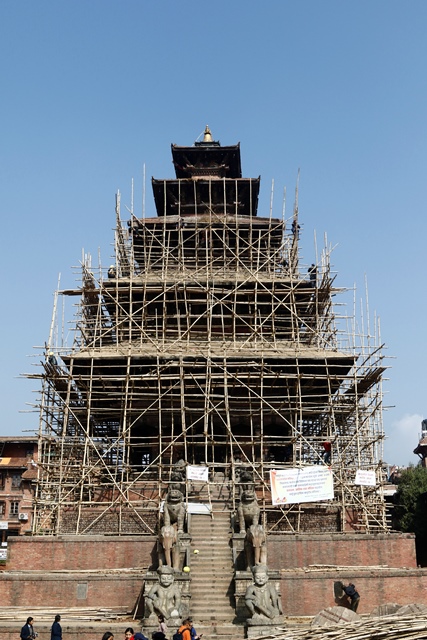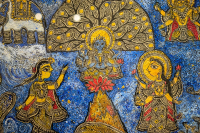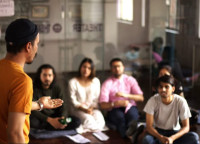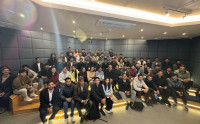Culture & Lifestyle
Bhaktapur’s famed Nyatapola receives post-earthquake facelift
The reconstruction of the early 18th-century temple marks the continuation of local participation in rebuilding heritage monuments..jpg&w=900&height=601)
Shashwat Pant
On a cold winter morning, a group of men are gathered at the base of Nyatapola temple in Taumadi Square, Bhaktapur. They are waiting for another delivery of bamboo, which they have been using to build scaffolding around the famed temple. Five years after 2015’s deadly earthquake, the reconstruction has just begun.
“We feel we owe it to the goddess,” says Ram Krishna Kiju, a resident of Suryabinak in Bhaktapur, who is taking part in the restoration of the temple. “The sooner we rebuild her home, the better our lives will become.”
Bhaktapur has been commended for using local resources, both financial and labour, to build the toppled monuments around the Durbar Square area. Even when foreign donors offered help, especially the German government, the municipality declined. In all Durbar Square areas around the Valley, the main contention between the local communities and the government has been participation.
Although the municipality aimed to complete all reconstruction work by the end of 2019, the reconstruction of Nyatapola temple could only begin at the onset of 2020. But like all other monuments in Bhaktapur, this one is being built by a user’s committee.
“We feel that giving it to user groups is a more effective way to do heritage reconstruction,” says Sunil Prajapati, mayor of Bhaktapur. “The groups are made up of locals who will connect more with the monument than contractors.”
The reconstruction will be ready by the end of April 2020, according to the mayor. He also attributes the success of all the earlier reconstruction projects to the locals’ participation. The heritage sites are intrinsically connected to the religious and cultural aspects of the locals, and their participation in its construction were seen as their way to take ownership.
But unlike for other monuments, Nyatapola doesn’t require full reconstruction. In 2009, the temple went through restoration, which Keshav Tamakhu, the user committee’s president, says prevented the quakes from destroying the temple entirely, unlike other monuments, which lay as shadows of their former selves.
According to Tamakhu, the temple mostly needs work on the top two floors. He says the top floor had tilted significantly to the east, while the floor below had also slightly tipped in the same direction.
“The plan as of now is to demolish the top two floors and rebuild, because they’re in a poor state. We have consulted a lot of experts who have also told us to do so,” says Tamakhu.
The budget for the restoration has been set at Rs 6.3 million, but Tamakhu believes the project will be completed for less.
“We don’t have to do much because part of the temple was strengthened in 2009, where a lot of old wood was replaced,” says Tamakhu. “It has significantly reduced the cost of the project.”
The main concern now for the restoration committee is to get pahelo mato, a form of mud which was used for heritage construction in ancient times. It’s sticky and helps cement the bricks together, and is also quite rare. Since the committee is looking to rebuild the temple in the traditional way, they also want to incorporate this specific type of mud. But according to Tamakhu, due to urbanisation, it has been difficult to find pahelo mato, which used to be easily available.

Even though the restoration work has just started, the study for the monument’s restoration began at the end of 2015, says Rajani Joshi, deputy mayor of Bhaktapur Municipality. In order to ensure the restoration projects went smoothly, the municipality also hosted two conferences, which brought together international engineers and architects, to discuss how to take the reconstruction forward.
“Those conferences helped a lot. Our own people gained a lot of exposure, and we learnt a lot about what to do and what not to do,” says Joshi, who is also an architect.
She also says most of the work done in the municipality came from architects of two colleges—Khowpa Engineering College and Khowpa College of Engineering, which also offers earthquake-related courses.
Joshi says while the restoration blueprint has yet to be finalised, all the other studies have been completed.
“The damage assessment has been done, along with various other surveys,” she says. “The report, which will soon be available to the public, will show how we worked with both local and foreign experts—architects, engineers, historians and archaeologists. These people now work with the committee and the locals restore heritage monuments.”
The holistic approach to reconstruction in Bhaktapur is the primary reason the work on heritage sites is almost complete in the municipality.
The 18th-century temple also holds a lot of cultural significance in the city. Apart from being the tallest pagoda-style temple in Nepal, it is also home to Siddhi Laxmi, the Mallas kul-deuta (ancestral god). There is also evidence the construction of the temple, from its foundation to installing its pinnacle, was completed within a period of six months.
“It seems unbelievable but there is proof. Dr Janak Lal Vaidya has mentioned in his works how then-King Bhupatendra Malla kept records of the construction of the temple in 1701. It has every detail and is available at the National Archives,” says Dr Prushotam Lochan Shrestha, professor of history and culture at Tribhuvan University.
Vaidya has translated the “Siddhagni Kotyahuti Devala Pratistha” manuscript, which has also since been translated into English. The reconstruction committee has also followed the translated works of Vaidya, in order to understand the historical background of the construction of the temple, and have an accurate blueprint as much as possible.
Although the earthquake destroyed many historical monuments, Shrestha says the silver lining has been people’s renewed interest in their culture. This is the reason younger generations have been vigilant about heritage reconstruction and demand participation.
“It’s a cultural rejuvenation of sorts. The locals, including children, are now more aware of their heritage than history books could have ever taught them,” he says. “I think the municipality should also be given a lot of credit for this. The local representatives have moved beyond their political agendas, and have worked to preserve culture through local participation.”




 6.73°C Kathmandu
6.73°C Kathmandu















